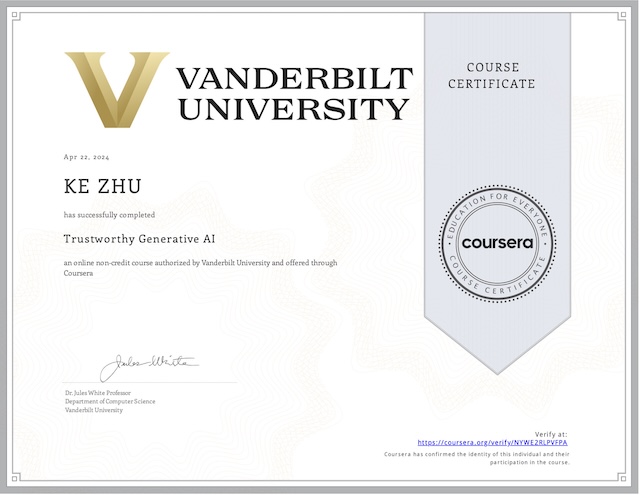Artificial intelligence, or AI, has been around for years. By learning from vast amounts of existing data, AI can be used as the simulation of human intelligence by machines. There are two fundamental approaches to AI:
| Discriminative AI | Mimic our analytical and predictive skills. An approach that learns to distinguish between different classes of data. Best applied to classification tasks, however it can not understand context or generate new content based on a contextual understanding of the training data. E.g.: Is this image a drawing of a nest or an egg? |
| Generative AI | Mimic our creative skill. An approach that capture the underlying distribution of the training data and generate novel data instances. E.g.: Draw an image of a nest with a few eggs in it. |
The creative skills of generative AI come from generative AI models, which are created using deep learning techniques, such as:
- Generative adversarial networks (GANs)
- Variational autoencoders (VAEs)
- Transformers
- Diffusion models
These models set the stage for generative AI’s growth and the development of foundational models and tools, which are with broad capabilities that can be adapted to create more specialized models or tools for specific use cases.
A specific category of foundation models called large language models (LLMs) are trained to understand human language and can process and generate text. Based on patterns and structures learned during training, LLMs interpret context grammar and semantics to generate coherent and contextually appropriate text. Drawing statistical relationships between words and phrases allows LLMs to adapt creative writing styles for any given context. The well-known LLMs include OpenAI’s GPT, Google PaLM and Meta’s Llama.
Applications
ChatGPT is a tool based on GPT as the large language model and uses advanced natural language processing (NLP). ChatGPT offers diverse capabilities for text generation. With the newer versions, it can take both image and text inputs. Another popular text generation tool is Google Bard based on Google PaLM. You’ll notice that ChatGPT is more effective in generating dynamic responses and maintaining conversational flow. While Bard may be a better choice for researching the latest news or information on a topic as it has access to web sources through Google Search.
OpenAI’s DALL-E is based on the GPT model, trained on larger datasets of images and their textual descriptions. DALL-E can generate high resolution images in multiple styles, including photorealistic images and paintings. Stable Diffusion is an open source text-to-image diffusion model. Diffusion models are generative models that can create high resolution images. Stable diffusion is primarily used to generate images based on text prompts, though it can also be used for image-to-image translation in-painting and out-painting.
Generative AI audio and video tools can make an impact, either. With the simple text prompt, you can produce human-sounding speech in multiple languages, record songs, add sound effects, or remove unwanted noise, publish professional videos and animations, build enhanced and exotic virtual worlds.
Generative AI model models and tools for code generation can generate code based on natural language input. These models comprehend the context and produce contextually appropriate code. Code generators can generate a new code snippet or a program from a text prompt. They can predict lines of code to complete a partial code snippet. They can also produce optimized versions of existing code. Even, these code generators can convert code from one programming language to another.
Prompts
A prompt is any input you provide to a generative model to produce a desired output, they are used to query and question AI applications, and optimize the response of generative AI models. Prompts that are effective and direct will allow you to generate more precise and relevant content. Prompts can also be a series of instructions that refine the output step by step to achieve the desired result. Based on these natural language requests submitted as prompts, generative AI models collect information, derive inferences, and provide creative solutions.
Naive prompting means asking queries from the model in the simplest possible manner. For example:
Sunset image between mountains.
However, to convey your intentions to the model, you can radically improve the result, if the prompt have context to proper structure and can be comprehensible. You can rewrite the prompt as:
Generate an image depicting a calm sunset about a river valley that rests amidst the mountains.
The building blocks of a well constructed prompt include:
| Instruction | gives the model distinct guidelines regarding the task you wish to execute. |
| Context | helps establish the circumstances that form the setting of the instruction and provides a framework for generating relevant content. |
| Input data | |
| Output indicator | offers benchmarks for assessing the attributes of the output generated by the model. |
Prompt Engineering
If you fail to provide precise prompts to generative AI models, these models may produce inadequate results and even false and misleading information. Prompt engineering is a well-structured iterative process that involves refining the prompts and experimenting with various factors that could influence the output from the model:
- Define the goal
- Craft initial prompt
- Test the prompt
- Analyze the response
- Refine the prompt
- Iterate the process
Beyond asking the right question, it includes framing the question in the right context with the right information, and your expectation of desired outcomes to elicit the most appropriate response. It is a blend of critical analysis, creativity, and technical acumen.
Prompt engineering is important, they:
| Optimize model efficiency | allowing the users to harness the full capabilities of these models without requiring extensive retraining. |
| Boost performance for specific tasks | delivering responses that are nuanced and have a context. |
| Understand model constraints | helping us understand model’s strengths and weaknesses. |
| Enhance model security | preventing issues of harmful content generation due to poorly designed prompts. |
Best Practices
You can apply the best practices for crafting effective prompts across four essential dimensions:
Clarity | Context
|
- - - - - - - - - - - - -|- - - - - - - - - - - - - - -
|
Precision | Role-play / Persona patternTo have clarity in your prompt:
- Use clear and concise language
- Avoid jargon and complex terms
- Provide explicit instructions
Context always helps the model understand the situation or the subject. Don’t forget to give
- A brief introduction or explanation of the circumstances in which the response is required
- Relevant information or specific details like people, places, events, or
- Concepts help guide the understanding of the model
Be specific, if you’re searching for a particular kind of response. Examples incorporated within your prompts can help the model understand what kind of response you’re looking for and direct its thought process.
Prompts written from the perspective of a specific character or persona can help the model generate responses aligned with that perspective.
Common Tools
These tools are specifically useful for users who may not be proficient with natural language processing or NLP techniques, but want to achieve specific outcomes when using generative AI models. Usually these tools can:
- Offer suggestions for prompts
- Suggest how to structure prompts for better contextual communication
- Refine prompts iteratively
- Mitigate bias
- Be relevant to specific domains
- Offer libraries of predefined prompts
Text Prompts Techniques
In recent years, there has been a significant advancement in natural language processing, or NLP, by using large language models, or LLMs. However, as the size and complexity of LLMs continue to increase, questions about their reliability, security, and potential biases have surfaced. Using text prompts effectively is a promising solution to these concerns
Text prompts are carefully crafted instructions that direct LLM behavior to generate a desired output. Certainly, the quality and relevance of the generated output depend on the effectiveness of the text prompt and the capability of the LLM. There are techniques that make text prompts effective:
| Task specification | Text prompts should explicitly specify the objective to the LLM to increase accurate responses. |
| Contextual guidance | Text prompts provide specific instructions to the LLMs to generate relevant output. |
| Domain expertise | Text prompts can use domain specific terminology when you need LLMs to generate content in specialized fields, like medicine, law, or engineering, where accuracy and precision are crucial. |
| Bias mitigation | Text prompts provide explicit instructions to generate neutral responses. |
| Framing | Text prompts guide LLMs to generate responses within required boundaries. |
Zero-shot prompting is a method wherein models generate meaningful responses to prompts without prior training. However, often you will not get the desired response in one prompt, and you may need to iterate. This is where the user feedback loop technique comes, where you provide feedback to text prompts and iteratively refine them based on the response generated by the LLM.
Similarly, for complex tasks, when you are unable to describe your needs clearly, a technique called few-shot is used. It enables in-context learning wherein demonstrations are provided in the prompt to steer the model to better performance. The demonstrations act as conditioning for subsequent examples where you would like the model to generate a response.
Approaches to Prompt Engineering
| Interview pattern | A strategy that involves designing prompts by simulating a conversation or interacting with the model in the style of an interview. 1. User provides prompt instructions 2. Model asks necessary follow-up questions 3. Model draws info from the responses 4. Model processes the info to provide an optimized solution |
| Chain-of-Thought | A prompt-based learning approach that involves constructing a series of prompts or questions to guide the model to generate a desired response. It involves breaking down a complex task into smaller and easier ones through a sequence of more straightforward prompts, with each prompt building upon the previous one to guide the models toward the intended outcome. |
| Tree-of-Thought | An innovative technique built to expand the capabilities of the chain-of-thought prompting approach. It involves hierarchically structuring a prompt or query akin to a tree structure to specify the desired line of thinking or reasoning for the model. It involves generating multiple lines of thought resembling a decision tree to explore different possibilities and ideas. Unlike traditional linear approaches, this technique allows the model to evaluate and pursue multiple paths simultaneously. Each thought or idea branches out, creating a treelike structure of interconnected thoughts. The model proceeds by assessing every possible route, assigning numerical values according to its predictions of outcomes, and eliminating lesser promising lines of thought, ultimately pinpointing the most favorable choices. |
Image Prompts Techniques
An image prompt is a text description of an image that you want to generate. There are different image prompting techniques that can be used to improve the impact of images:
| Style modifiers | Descriptors used to influence the artistic style or visual attributes of images. |
| Quality boosters | Terms used in an image prompt to enhance the visual appeal and improve the overall fidelity and sharpness of the output. |
| Repetition | This technique leverages the power of iterative sampling to enhance the diversity of images generated by the model. Rather than producing just one image based on a prompt, the model generates multiple images with subtle differences, resulting in a diverse set of potential outputs. This technique is particularly valuable when generative models are confronted with abstract or ambiguous prompts to which numerous valid interpretations are possible. |
| Weighted terms | Use of words or phrases that can have a powerful emotional or psychological impact. |
| Fix deformed generation | Modify any deformities or anomalies that may impact the effectiveness of the image. |
By incorporating these techniques, one can create more memorable, engaging, and persuasive visuals that can effectively communicate the intended message.
Generative AI in Software Development
Generative AI has the potential to revolutionize software development in various ways:
- Automation – streamline repetitive tasks, reduce manual effort, and increase productivity.
- Code optimization – identify areas where the code can be optimized to improve performance or reduce memory usage.
- Bug detection and troubleshooting – provide insights into potential issues before they become critical.
- User experience – analyze user feedback and extract valuable insights by understanding user sentiment and preferences.
- Augment creativity – create new and innovative designs for user interfaces or generate realistic test data.
- Automated code generation – expedite the prototyping process, enabling quick iterations and refinements.
- Code refactoring – analyze code and identify areas for improvement in software development projects.
- Smart documentation – extract relevant information, generate descriptive documentation, and provide contextual explanations for code snippets, functions, and modules.
Software Development Lifecycle (SDLC) has certain phases: Requirement gathering and analysis, Design, Development, Testing, Deployment, and Maintenance. AI can be applicable to all of them.
Large Language Models
Large language models (LLMs) undergo extensive training, using deep learning techniques, on massive data sets containing texts from various sources like books, articles, and websites. This training equips LLMs to recognize language patterns, allowing them to produce coherent and contextually relevant text.
LLMs excel in natural language processing, enabling them to perform tasks such as text generation, translation, summarization, sentiment analysis, and question answering. LLMs help in code generation and auto-completion. It is great for automated bug detection and fixing. It serves as a natural language programming interface, to enable communication with code using plain English or other natural languages. However it is still important to maintain a balance between human expertise, and machine-generated code.
Natrual Language Processing
Natural language processing, NLP, involves using computational techniques to analyze, understand, and generate human language. It combines aspects of linguistics, communal science, and artificial intelligence to process natural language data. NLP techniques enable computers to perform sentiment analysis, named entity recognition, text classification, machine translation, and more.
A few linguistics concepts form the foundation of NLP:
- Morphology – study of world structure
- Syntax – study of sentence structure
- Semantics – study of meaning
Text processing and cleaning techniques is an essential step, which involves transforming raw text data into a format suitable for analysis. Tokenization is the process of dividing text into similar units called tokens. Stemming is a technique that reduces the words to their base or root form. It helps in standardizing words and reducing the vocabulary size.
Major use cases of NLP include:
- Text processing – preprocess and clean textual data, tokenization, stemming, spell correction.
- Named entity recognition – extract names of entities (persons, organizations, locations, or date)
- Text classification – spam filtering, content classification, sentiment classification, topic modeling
- Chatbot and conversational agents – understand user queries and generate response
- Information extraction – resume parsing, news aggregation, and data mining
NLP technology raises ethical concerns about privacy, bias, fairness, transparency, and accountability. Ensuring fairness in algorithms is important to prevent discrimination. Responsible use of NLP involves addressing ethical considerations throughout the development life cycle.
CI/CD
CI/CD stands for continuous integration and continuous development or deployment. Imagine AI is integrated into CI/CD workflow, as developers make code changes, the AI tools automatically recognize critical test cases, drastically reducing testing time, and minimizing manual effort. There are a few areas that AI is reshaping CI/CD:
- Automated testing and quality assurance
- Code analysis and optimization
- Software deployment
- Release orchestration
- Monitoring and feedback
In the future, AI will help achieve AI-driven operationalization, elevate delivery health insights, and automate verification.
For more on Introduction to Generative AI, please refer to the wonderful course here https://www.coursera.org/learn/generative-ai-introduction-and-applications
I am Kesler Zhu, thank you for visiting my website. Check out more course reviews at https://KZHU.ai



